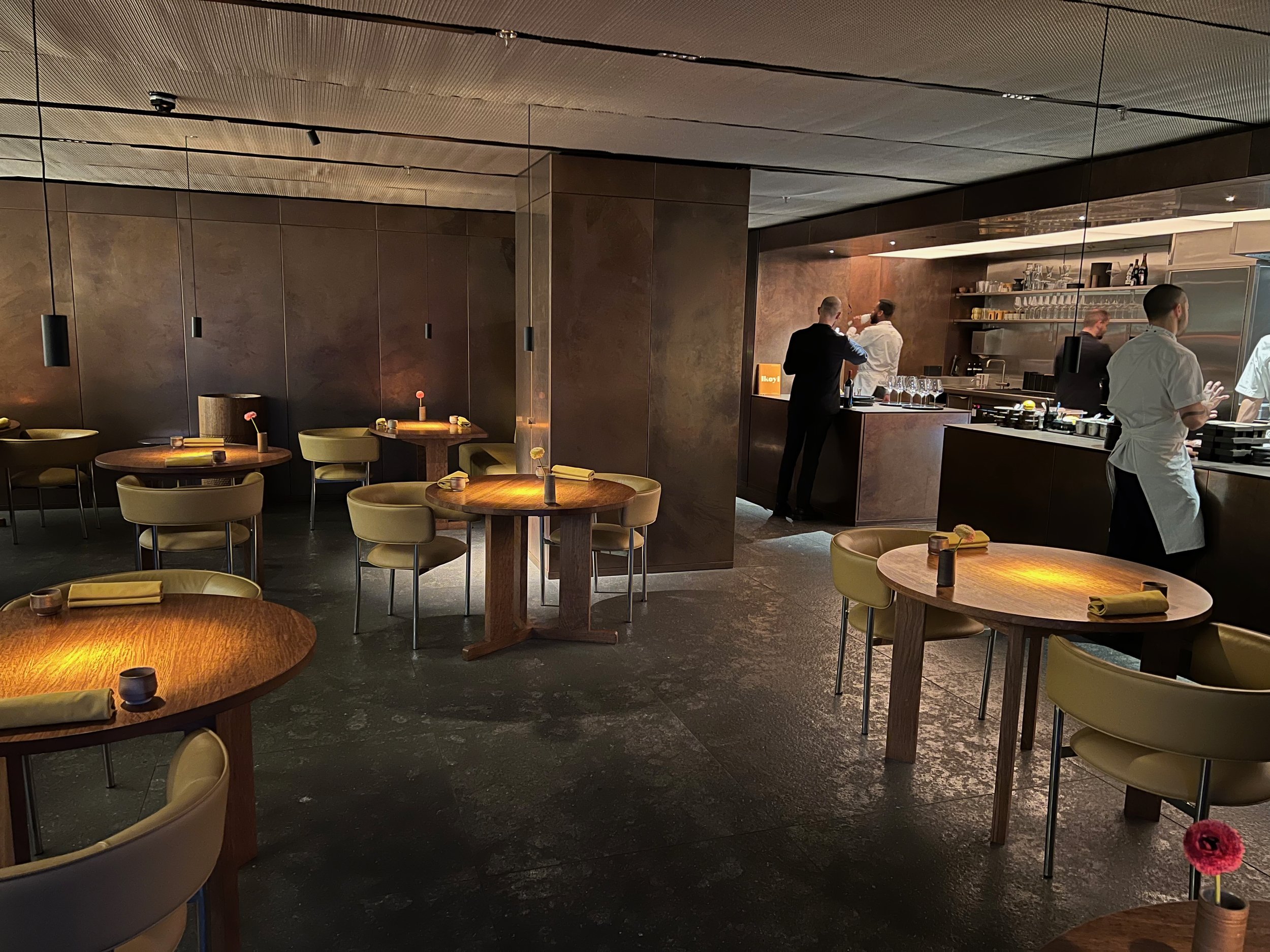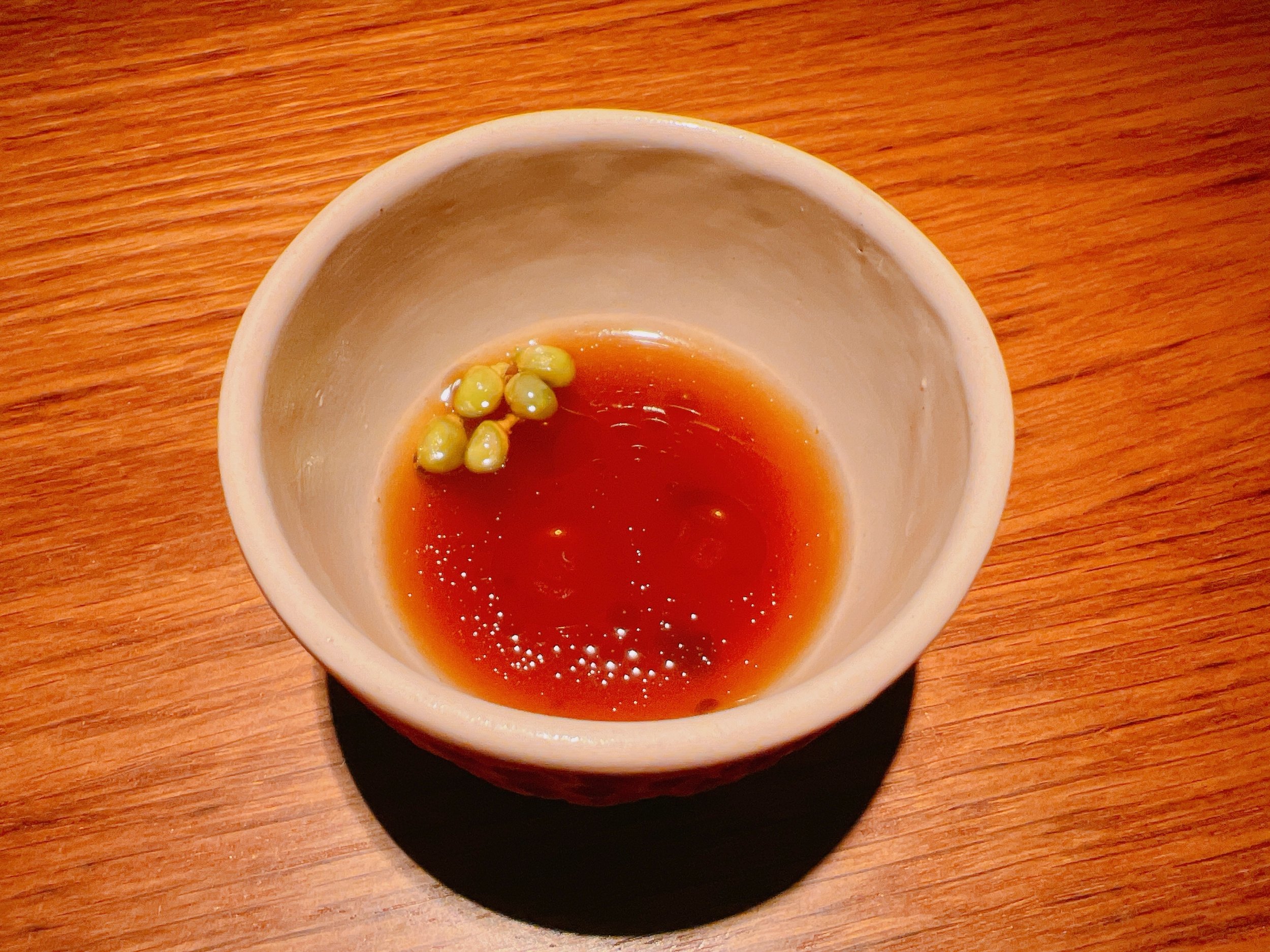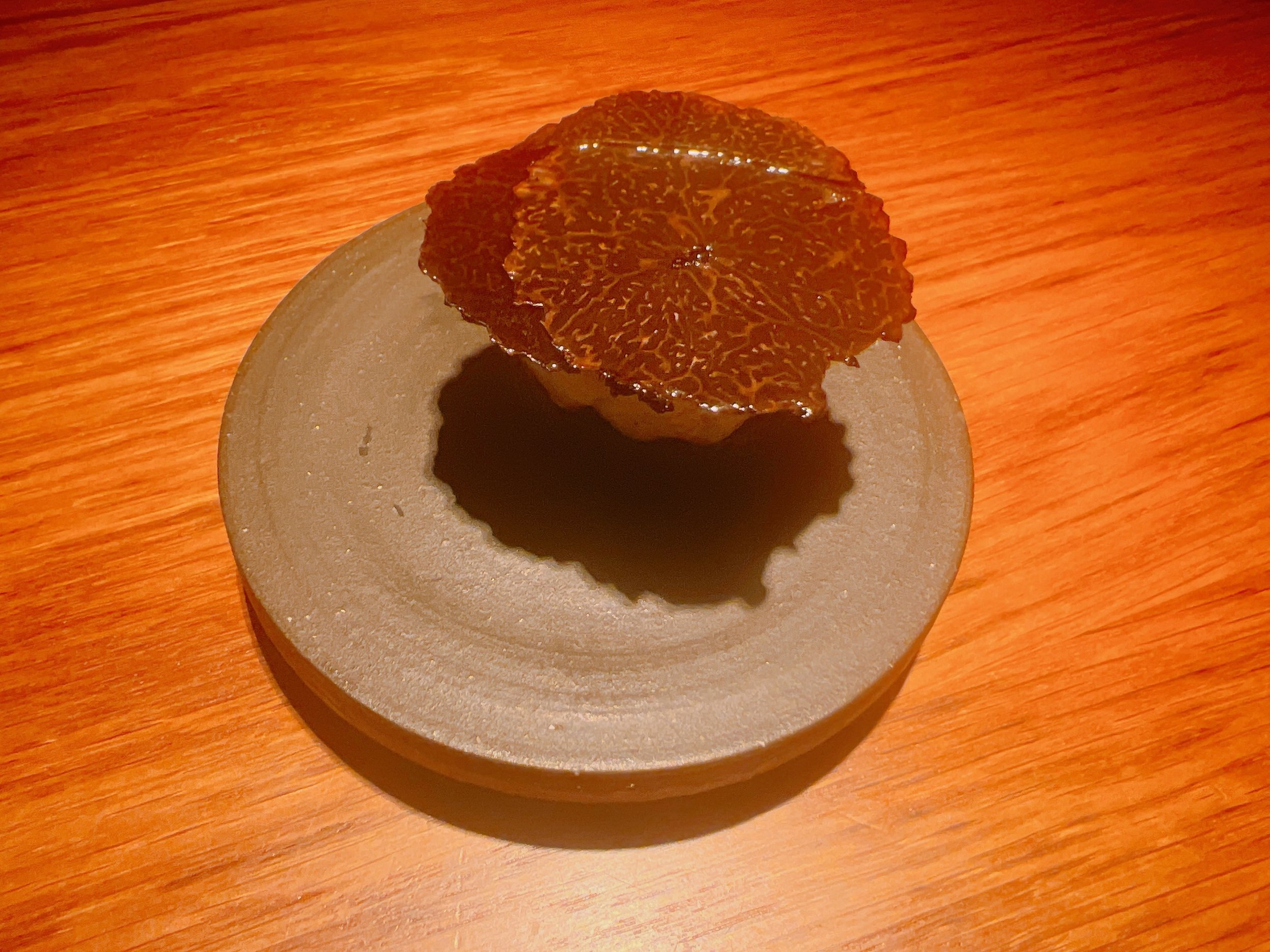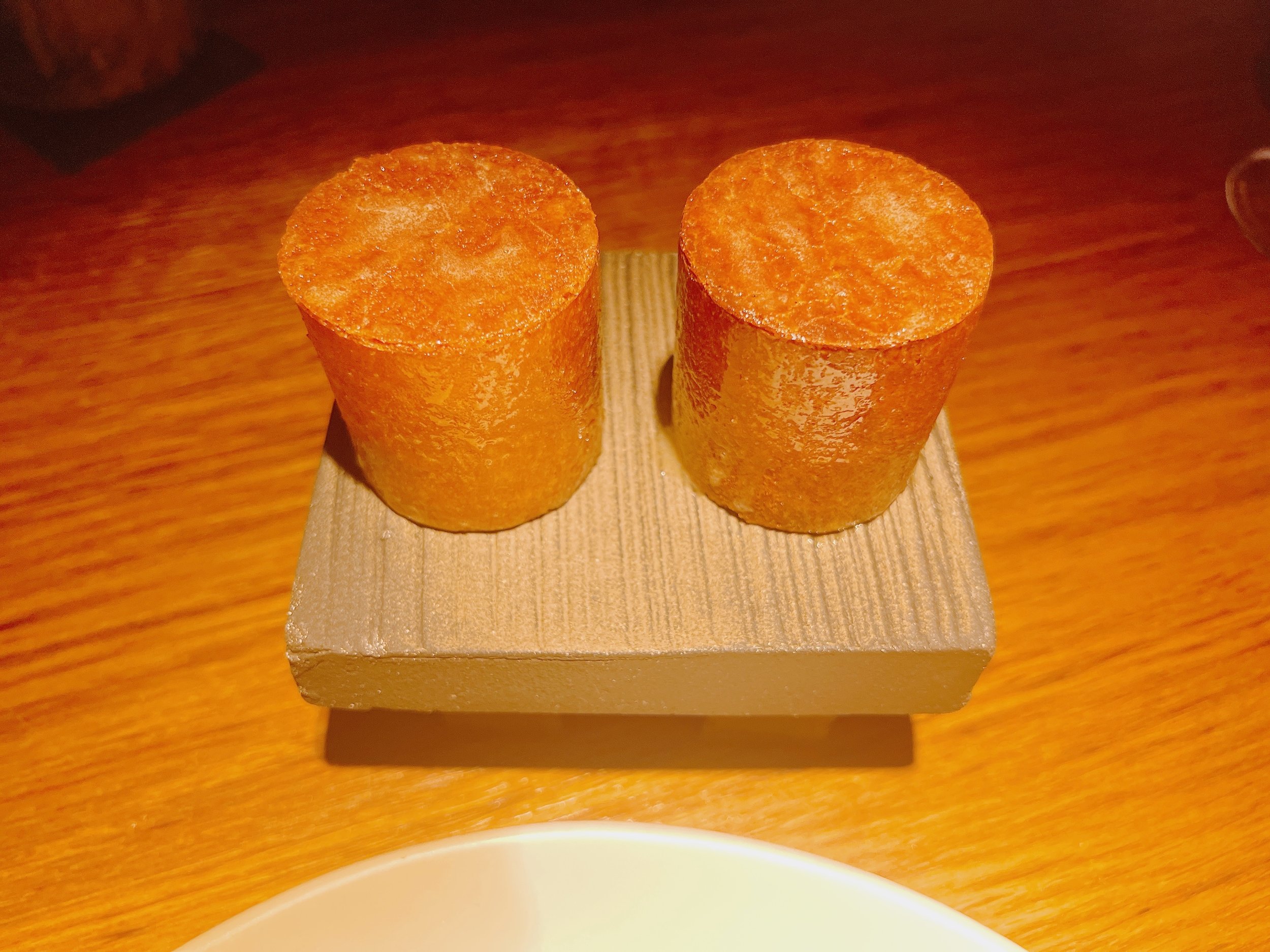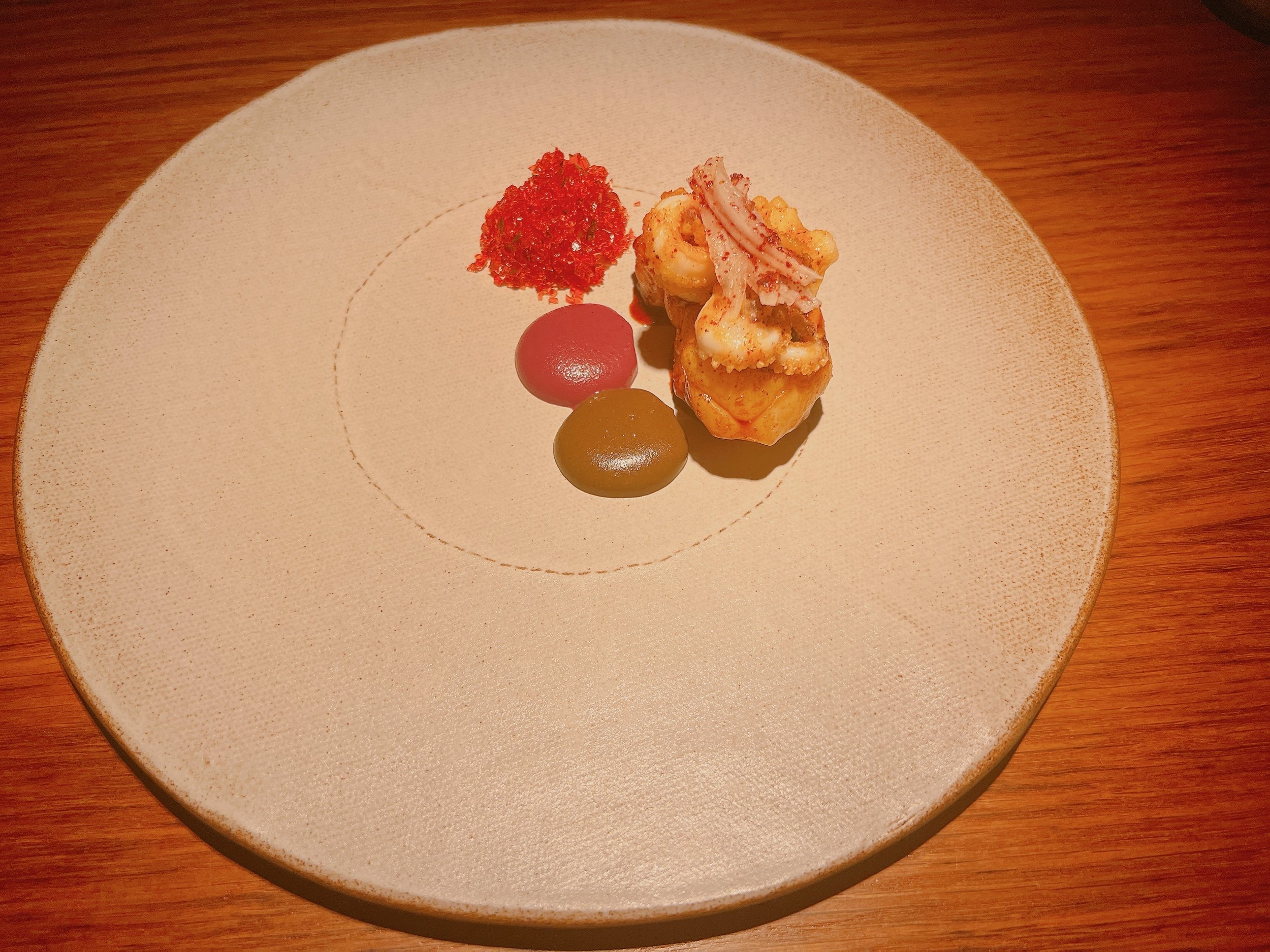Ikoyi - London
Rating: 17/20
Where: London, UK
When: Dinner for 2 on 8 March 2024
Cost per Person: Tasting menu £300, Wine pairing £150
Accolades: 2 Michelin Stars, #35 on 50 Best Restaurants list (2023)
Why: Dishes full of spices that also balance sweetness and savoriness
London’s “Ikoyi” is a fine-dining restaurant that isn’t easy to categorize. Its most distinctive feature is the abundant use of spices, most of them coming from Africa. However, the resulting cuisine is not African by any means: apart from the spices, it feels mostly Western in terms of techniques and ingredients. Not your typical two-Michelin-starred restaurant then, and therefore one of our dinner destinations during a recent trip to London.
Ikoyi is located on the Strand, at the north-west corner of a 1970s building that has recently been renovated to give it a more contemporary flair. The restaurant's interior design is somewhat stark in its minimalism, and favors brown colors. Most tables have a good view of the open kitchen.
On our visit, the restaurant offered only a single tasting menu, but dietary restrictions were taken into account. Wine, sake and tea pairings were available as well, and we tried the wine pairing. The six paired wines were mostly in the “fair, not great” category, but went pretty well with the food. Given the difficulty of pairing wines with food that's not only spicy but also combines several different flavors in every single dish, that was actually quite an achievement. This challenge probably explains why most wines were noticeably acidic. The one wine that was relatively easy to pair - the dessert wine - was outstanding, however.
The service was excellent: friendly and knowledgeable about the food and drinks to an astonishing degree - it felt like we could have deep-dived into the details of each dish's preparation until the food went cold. And rather than having only one fixed server, we had almost the whole staff, including the chef, stopping by our table at one time or another to deliver a dish or pour a glass of wine. They made coordination look easy.
Our dinner started with a series of appetizers. First, a broth made from vegetables and chicken contained a few teardrop peas and was seasoned table-side with gola pepper oil. A nice introduction: peppery, with a distinctive chicken flavor and some sweetness from the expensive peas 17.
After that, a poppy-seed croustade was filled with beef and topped with asparagus, collard greens, trout and sweet orange slice. Quite a wide range of ingredients, and also quite large for something to be eaten in a single bite. There was a lot going on here - whereas appetizers often focus on single flavors, this one was an orchestra of them. To be honest, I didn't fully know what to make of the combination, but maybe that was the point - a preview of what was to come. With a hint of spiciness to the beef, this bite was quite good overall 17.
A thin cracker shell held a smoked and pickled quail egg, some caviar, the tip of a green asparagus and (if I'm not mistaken) some Béarnaise sauce. Another largish dish that had to be eaten in a single bite. The egg was only lightly smoky, the cracker had a light crunch, and eaten together, it was hard to detect the caviar. Similar to the previous bite, the flavors tumbled on top of each other and were hard to distinguish 16.
The final appetizer was a squid ink toast topped with “drunken” squid and a slice of black truffle. The toast was warm, whereas the rest of the dish was served cold. The creamy squid was quite nice, but there wasn't much truffle flavor, and the toast felt a bit heavy, as if it had been cooked in butter 16.
The first official course was served in a bowl with a saffron creme caramel at the bottom. It was topped with a generous helping of Kaluga caviar, a circle of sliced razor clams, a beetroot broth and a few drops of a saffron-infused chili oil. The different flavors in this dish combined in a more straight-forward way than in some of the appetizers. The caviar was of good quality and added some nice saltiness to the dish. Surprisingly, the creme caramel was not sweet at all, and mainly provided a creamy texture to the dish. The clams were nicely cooked - tender and with just a minimal bite. A great combination 18.
A scallop from Orkney came with a beurre blanc, some greens, a hazelnut mousse, a pickled slice of rhubarb and a coconut squash sauce. The scallop was also cooked nicely and the greens were flavorful - overall this was an interesting combination of sweet and savory, with some acidity provided by the rhubarb. Not bad, but maybe there was a bit too much going on 17.
Sweetbreads were crusted with a spice blend called “suya”. Next to them was a pan-fried morel mushroom filled with a rye porridge that was seasoned with chili and dark chocolate. The mushroom sat on top of white creamed beans. Two sauces completed the dish: emulsions of wild garlic and black garlic, respectively. The sweetbread was meaty and quite spicy thanks to its suya coating, and the mushroom was excellent: juicy and flavorful. The beans had a slightly burnt flavor - not ideal. The sauces were not spicy, which allowed them to lighten the dish a bit. The wild garlic’s taste was very subtle compared to the rest of the dish, but the black garlic added a bit of sweetness. A nice dish with a spicy aftertaste 16. Not being a great fan of sweetbreads, I actually preferred the pescatarian alternative, a perfectly cooked octopus that was tender and juicy 18.
For me, the highlight of our meal was the following turbot. Dry-aged for five days, it had been grilled (and had the grill marks to prove it), and was served with a crab butter, a piece of squash, a carrot mousse, and three different kinds of pickled beets. Next to the plate was a brioche that had a savory vegetable filling including chestnut mushrooms. The brioche had been shaped into a perfect cylinder and was caramelized with honey butter. Back to the fish: it was close to perfection - juicy, flavorful and with a nice grilled taste. The sauce was wonderful as well, and the beets provided a good, slightly acidic counterbalance to the fatty fish. The brioche was quite sweet (and slightly sticky) thanks to its coating, but overall lovely as well. The turbot and the brioche were good on their own, but being to mop up the sauce with the bread was a nice bonus. A strong 18.
On to the last savory course: a sirloin steak seasoned with pepper and topped with squid and slivers of onions. It came with two sauces - one made from dark chocolate, the other from pickled red cabbage (red sauerkraut, so to speak). Finally, there was a jelly made from kaffir limes. On the side came a plate filled with a fried rice called “jollof”, topped with a lobster sauce. Starting with the rice: it was lovely, but also very, very spicy. Indeed, it was the spiciest dish of the night - a lower intensity might have been better here, but at least it was followed by a palate cleanser that soothed our scorched taste buds. The steak was perfectly cooked, tender, and nicely seasoned with pepper. The squid was tender as well. Similar to the sweetbread, the sauces rounded out the dish without being too flavorful by themselves 17. The pescatarian dish replaced the beef by monkfish, and left everything else the same. The fish had a firm texture and a bit of smokiness - quite nice, but if I had to choose, I'd narrowly go with the beef 17.
Rum baba came reimagined as a “citrus baba”. A little cake was covered with slices of several citrus fruit - kumquat, tangelo and Meyer lemon - and then glazed with more Meyer lemon and some preserved Buddha's Hand. On its side was an English pine sorbet made with buttermilk. The fruit, hand-harvested and delivered directly from the Pyrenees, were excellent, and the slightly salty sorbet was a great complement. The only thing missing in this baba was the rum 18.
The main dessert of the night was an ice cream made from sugar that had been harvested from Palmyra flowers. It was served with a mousse flavored with red long peppers and uda seeds. All of this sat on top of malted barley crumbles and some pieces of rhubarb. Texture-wise, it was reminiscent of a crumbled-up ice cream sandwich. The crumbles had a nice texture, and the flavor of the ice cream was interesting - it had a hint of fruitiness 18.
Two small bites to finish our meal. A verbena berry jelly topped with citrus confit was fruity with tones of lemon. A ostensibly simple dish where each ingredient was clearly identifiable 18. Finally, a small tartlet was filled with a Cuban chocolate ganache, suda spices and shredded Catalonian black truffles. The ganache was a bit salty, and the tarte had a light crumble, whereas the truffle didn't add so much truffle flavor as enhance the umami taste of the dish 17.
Overall: A very unique take on fine dining, where spices and combinations of sweet and salty featured strongly in almost all dishes. For me, this worked best when there was a fixed point to anchor the dish to - say the turbot -, and less well when all components seemed to pile on top of each other - like in some of the appetizers. In the latter cases, I tried and failed to find traces of the individual ingredients, and often didn't really know what to make of the dish. Maybe with repeat visits, one would feel less overwhelmed, and the restaurant's philosophy might come more clearly into focus. But it was a fun ride nevertheless 17.
